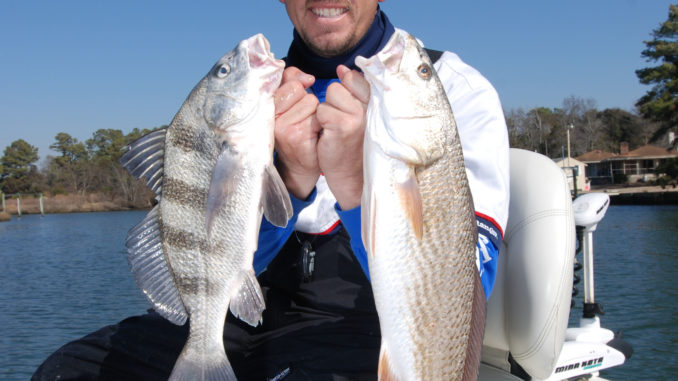
Abundant docks, oysters and creeks offer great habitat for winter-loving fish and fishermen.
March is a notoriously fickle when it comes to weather. Windy days and chilly weather can pose problems for many anglers who try to fish the larger, open waters, but for those who watch the wind, heading across Bogue Sound to reach the protected headwaters of its small feeder creeks is key to consistent fishing success.
For Capt. Jeff Cronk, finding fish in the creeks is like a playing game of chess: picking a spot that is protected from the wind that day, then stalking along, trying to find just the right boat dock, seawall or oyster bed to test for the presence of fish. The fish that teem in these calm waters are red and black, just like the squares of a chessboard. Drum of either color may strike an angler’s offering on the very next cast.
“I was seeing schools of 50 redfish or more under these docks a couple of days ago,” Cronk said. “They’re probably still here, because they don’t move out of the creeks when it’s still cold.”
Cronk eased his boat within a dozen feet of the dock. With a spinning rod rigged with a float rig, he used an underhanded cast to flip the float back under the dock. A scented, Fluke-type lure on an unweighted hook settled slowly beneath the float.
“In the upper ends of these smaller creeks, there’s no wind or current flow,” he said. “That makes fishing the docks easy, because your rig won’t move and snag a piling. If the float moves sideways or trembles at all, you’d better set the hook.”
Cronk saw the float dip and hauled back hard on the rod. After powering a red drum away from the dock, landing it and releasing it, he moved the boat back into position with his trolling motor and eased down his Power Pole.
“I’ve caught dozens of redfish from a single dock,” he said. “Where there’s one, there are always more.”
Cronk caught several more redfish before moving farther back in the creek. As the trolling motor hummed, he cast an identical lure rigged on a quarter-ounce jighead to any structure, as well as away from the docks to prospect the underwater structure in the middle of the creek.
After hooking several red drum near the pilings and seawalls lining the banks, he eventually hooked a black drum weighing a couple of pounds away from any visible structure. Playing it to the boat, he landed it and stroked its dorsal fin erect in admiration.
“Black drum are in the creeks, too,” he said. “If you catch one on a scented lure, it’s a sure bet there are dozens more in the same spot.”
Cronk said black drum are not as likely to strike lures, even scent-impregnated soft plastics, as red drum. After catching one or two black drum, he switches to shrimp for bait.
“I buy fresh shrimp and freeze it, or try to find the freshest frozen shrimp I can,” he said. “Live shrimp are very expensive, and you don’t them alive for catching catch black drum. Red drum are going to eat your shrimp, too.”
Impaling pieces of shrimp on a standard 2-hook bottom rig with a 1-ounce tear-drop sinker, he cast to the same spot that had given up the first black drum. Soon, he was landing one or a pair of black drum on every cast, along with an occasional red drum.
“When I cast the bottom rig, it hit something hard,” he said. “From experience, I knew there was an oyster bed somewhere in that area. Black drum are going to be on the oyster beds. They will also be in the deeper holes in the creeks.”
Cronk fished for a couple of hours, boating red and black drum until he had caught at least two dozen fish of both species. The red drum ranged from 15 to 27 inches long, and the black drum weighed from one to three pounds.
“That’s about the size of the typical redfish you are going to catch in the creeks,” he said, “but I’ve seen black drum much larger. A 10-pounder is not uncommon, and you will occasionally see one or hook one that will go 30 to 50 pounds. But with the light tackle we’re using, you’re not likely to land it.”
Cronk used braided line to fend off break-offs amid all of the structure. He prefers 20-pound braid for pitching float rigs under docks and for bottom rigs, but he uses 10-pound braid for casting plain jigs.
Capt. Mike Taylor grew up fishing the same creeks as Cronk, and the two guides often share information. He also prefers using small-diameter braided line for fishing in creeks, but for different reasons.
“I use very light jigs, so I use a 6- to 8-pound braided line,” he said. “I use a 1/16th-ounce jig with a 3-inch scented paddletail or curlytail bait, and I want it to sink slowly down in front of the fish. The light jig also helps keep the lure out of the moss, which is covers the bottom of all of the creeks.”
Taylor also uses float rigs with oval floats like Cronk’s in early March. However, he switches to popping cork rigs at the end of the month.
“A popping-cork rig is more effective after the water has warmed into the mid-50s because the fish get more aggressive,” Taylor said. “I don’t pop it very hard. I let the lure settle and allow it to sit for a minute then pop it easy once or twice. That’s usually all it takes to draw strikes.”
Taylor said he eases into a creek, casting along one bank or the other. Once he locates a dock with a school of cooperative red drum, he puts down the Power Pole and fan-casts four or five rods baited with shrimp to the channel side of the creek for catching black drum. He keeps fishing until the bite tapers off, then heads back into the creek and continues to fish out of the creek along the opposite side.
“I fish the whole area,” he said. “Underwater oyster beds could be anywhere. The structure is not only in the places where you can see it. You should also look for the deep holes where people dock their boats. The bigger engines wash out the deepest holes, and those holes hold lots of black drum.”
Taylor said the creeks made the fishing comfortable because the banks blocked the wind. However, that was not the only reason he sneaks into the skinny water in March.
“When it’s cold, all of the baitfish head to the backs of the creeks because the water is warm,” he said. “You will find mullet, menhaden and other baitfish in the creeks by seeing them breaking the surface or spotting them on your depthfinder.”
Like having a queen as the power piece in a chess game, Taylor and Cronk use a secret bait when they want to beat the pants off of finicky red drum in a creek that is chock full of baitfish.
“A red drum will hit a mud minnow when he won’t hit anything else,” Cronk said. “Sometimes I fish a mud minnow on a float rig, but most of the time, I use a simple rig with just a split-shot and a small hook and hook the minnow through the lips to allow it to swim as naturally as possible. I catch live mud minnows in the backs of the creeks by finding a ditch no more than a foot or two across and setting a minnow trap baited with a can of cat food with holes punched in it. In a few minutes, I can catch a thousand mud minnows. But, since there are no bait stealers like pinfish in the creeks in March, you only need a few dozen. It’s easier for most fishermen to buy a few dozen mud minnows at one of the tackle shops or marinas.”
DESTINATION INFORMATION
HOW TO GET THERE/WHEN TO GO — To get to the Morehead City Boating Access Area, travel east on US 70 and go 2.7 miles past the intersection of US 70 and NC 24, then turn right next to the Visitor Center; the ramp is behind the building.Fish in mainland creeks along Bogue Sound and White Oak River, including Broad, Goose, Peletier, Spooner, Gales, Broad, Goose, Deer, Pettiford, Queen and Bear creeks. The best fishing is in March, when red drum and black drum get in tight schools, the water is clear, and creek banks can block the wind.
BEST LURES/BAITS — Capt. Jeff Cronk prefers a 3-inch Gulp! Alive Smelt hooked on an eighth- or quarter-ounce unpainted jighead. Capt. Mike Taylor uses a Gulp! Pogy paddletail or mullet curlytail soft plastic hooked on a 1/16th-ounce unpainted jig. Both guides use oval-shaped floats and popping float rigs with live mud minnows or scented soft plastics hooked on unweighted hooks or jigs. Another good bet is a live mud minnows hooked on a split-shot rig.
FISHING INFO/GUIDES — Capt. Jeff Cronk, Fish’n 4 Life Charters, 336-558-5697; Capt. Mike Taylor, Tailor-Made Charters 252-725-2623. See also GUIDES & CHARTERS in Classifieds.
ACCOMMODATIONS — Comfort Inn. Morehead City, 252-247-3434; Hampton Inn, Morehead City, 252-240-3100; Holiday Inn Express Morehead City, 252-247-5001; Sheraton Resort, Atlantic Beach, 252-240-1155; Windjammer Inn, Atlantic Beach, 252-247-7123; AmeriSuites, Atlantic Beach, 252-247-5118.
MAPS — Capt. Segull’s Nautical Charts, 888-473-4855, http://www.captainsegullcharts.com/; Sealake Fishing Guides, 800-411-0185, http://www.thegoodspots.com/; Delorme North Carolina Atlas and Gazetteer, 800-452-5931, http://www.delorme.com/.

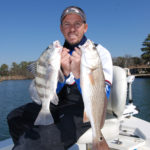
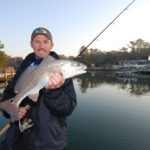
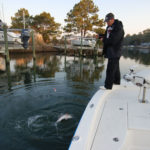
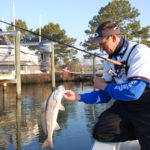

Be the first to comment